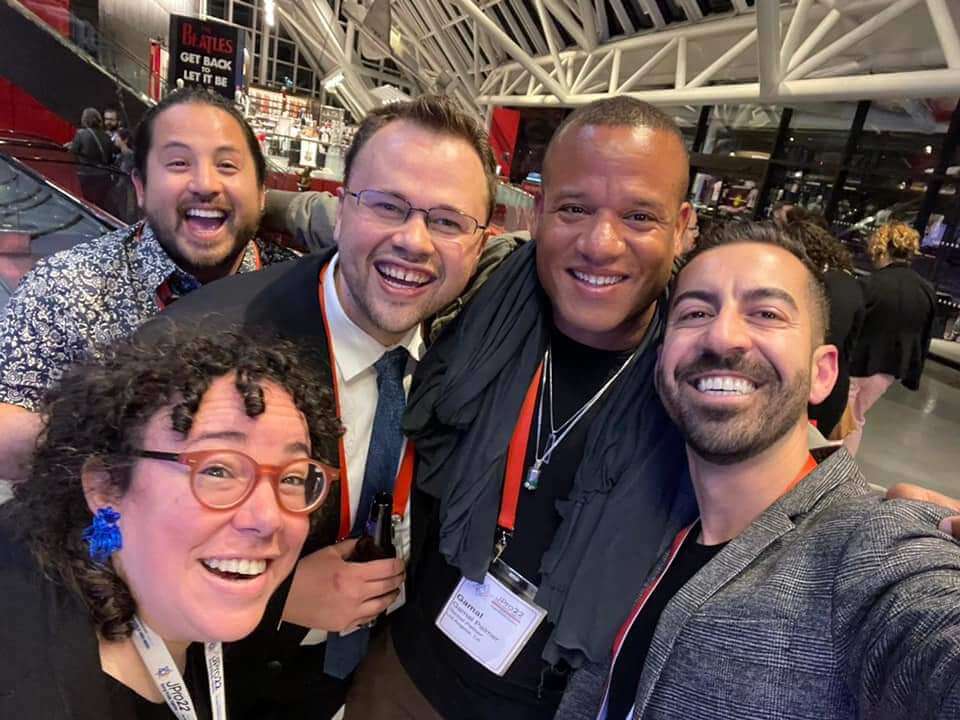Cleveland conference mirrored Jewish demographics — by design
At JPro22, 12% of attendees were nonwhite. It didn’t just happen by chance.

From left: Tema Smith, Yoshi Silverstein, Isaiah Rothstein, Gamal J. Palmer and Arya Marvazy share a moment at last month’s JPro22 conference in Cleveland, held in partnership with the Jewish Federations of North America. A survey showed 12% of attendees to be nonwhite, reflecting the demographics of the overall U.S. Jewish population according to the Pew “Beyond the Count” survey released last year. Courtesy of JFNA
For Jewish people of color, major national Jewish gatherings can be daunting and marginalizing. Often, we feel like we’re in a bubble where realities like racism are not addressed or not of concern to fellow Jews, or worse, that we do not belong. At other times, the challenging work being done on the ground by Jews of color is not acknowledged by our greater Jewish community.
But something dramatic happened in Cleveland last month at this year’s JPro conference, which was produced in partnership with Jewish Federations of North America.
As Jewish people of color, we saw reflections of ourselves throughout the conference from the co-chairs, speakers and workshop presenters. That was particularly noticeable in the demographics of the 1,200 attendees, which mirrored the diverse demographics of the Jewish community, likely for the very first time at a major, national Jewish event.
According to data compiled from the registrants, a full 12% were non-white. That figure is in line with the recent Pew Survey of American Jews, which found that 10% of Jews in North America identify as Sephardi and/or Mizrachi and 8% as Black Asian or Latin American. Additionally, 17% live in a household where at least one other member is a person of color.
The diversity extended beyond the racial and ethnic realm; 11% of North America’s Jews identify as LGBTQ+, 70% of us live in Jewish households with non-Jewish family members and 10% of us are Russian-speaking Jews. It should no longer be taken for granted — it never should have been in the first place — that Jews are a monolithic or homogenous people.
Many of us were struck by the collective sense of release that was brought about by the intentionality of quiet spaces, the culture of belonging created by consistent and inclusive language, the presence of “belonging ambassadors” throughout the conference, and the honest and genuine openness to new ideas from Jews of all backgrounds.
To a packed audience, Tamara Fish, the conference’s co-chair and founder of Khazbar, which describes itself as a “network by and for JOCism,” and Nate Looney, the director of Community Safety and Belonging for the Jewish Federations of North America, articulated their personal experiences enriching the Jewish community as Jewish people of color.
What we experienced was not a coincidence. It was intentional, by design, the result of a process of collaboration and hard work.
One major factor that allowed this to move forward was leadership that sought out our collaboration and input from the get-go, and made sure that Jewish equity, diversity and inclusion was not just a slogan but a value to live by.
JPro CEO Ilana Aisen and JFNA Executive VP Shira Hutt were enthusiastic partners, working closely with Rabbi Isaiah Rothstein, who leads JFNA’s JEDI initiative, to bring a multitude of voices and perspectives to the conference planning.
By fostering collaboration with diverse Jews, JPro22 expanded the tent of the Jewish community and invited all to enter and to contribute.
As a result of these partnerships, we were able to help build and participate in a gathering grounded in JEDI values that will serve as a model for how to incorporate these commitments into every aspect of our communal gatherings — including the ways that we recruit and welcome our attendees, choose our speakers, structure our meeting spaces, and frame our conversations.
Looking back at the event, we can take pride in all the different skeins, fabrics, and hues that make up our contemporary Jewish community and that will continue to guide, thrill and inspire us as we move forward into the next stage of North American Jewish life.
It was just a few years ago that historians were writing about how European Jews “became white” during the postwar era in America, leaping from racial outsider status to a place of privilege. Now, in the wake of Black Lives Matter, the Jewish community is waking up to the fact that we are a multiracial community.
We can toss all the old “you don’t look Jewish” jokes in the trash. There’s no one way to “look Jewish.”
There never was.

























